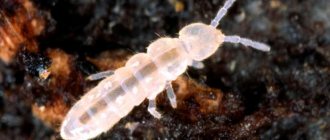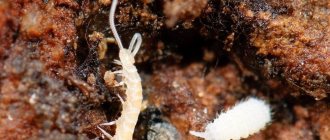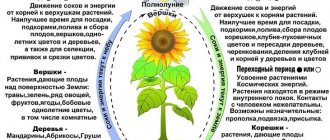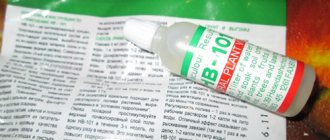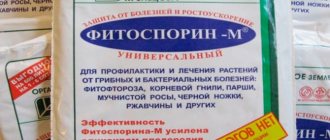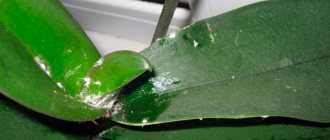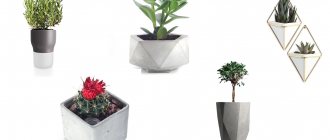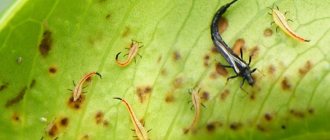Brown and tan spots on leaves
Trips
Signs: Brownish-brown spots are visible on the underside of the damaged leaf, and whitish and silvery streaks are visible on the upper side, which are left by thrips as they crawl from leaf to leaf.
Then the leaves may turn yellow, dry out and fall off. Flowers become stained and deformed. Features of the pest: An insect with an oblong and black body with two pairs of wings. Lays white larvae, which later turn light yellow and have a transparent bubble on the back. They are collected on the underside of the leaf near its veins. Eggs are laid in leaf tissue. Method of control: Leaves are washed with water and dissolved laundry soap. For complete destruction, pyrethrum diluted in water (2 g per 1 liter of water) is used for spraying, which is done twice with an interval of 8-10 days. They also use the slightly toxic drug thiophos (0.1-0.2%) or the moderately toxic ones - Nurell-D, Vertimek. Spraying with a decoction of cyclamen tubers, infusion of tobacco and yarrow also gives results. For prevention, it is important to spray the plant with water, maintaining sufficient humidity
Onion root mite
Signs: Tick passages are visible. The affected parts of the plant are filled with brown dust. Features of the pest: Small (up to 1 millimeter) yellowish or white mites that attack bulbous, tuberous plants, and orchids. Method of control: Affected bulbs and tubers are destroyed. The earth is dried out.
How to get rid of midges in flower pots
In the question of how to get rid of midges in a flower pot, folk remedies will help:
- Make living in your flower pots uncomfortable, dry the soil and loosen it regularly for better access of oxygen to the roots. When the soil is waterlogged, plant roots lack oxygen. Compliance with the watering regime will prevent new pests from appearing.
- In order to prevent pests from spreading to other indoor flowers, catch all adult insects. For this you can use special traps. This could be fly tape. You can make such devices yourself. Take cardboard or thick yellow paper, cut suitable squares and brush them with honey, then place them near the flower pots. Change traps when they dry out or become full of midges.
- Adult midges can be controlled mechanically using a vacuum cleaner. Simply remove the attachment and vacuum up potted soil and flying gnats. Dispose of the bag or treat it with dichlorvos.
- The next step is to destroy the larvae in the soil. Prepare one of these solutions. Per one flower pot: grate or chop 1 head of garlic with a knife, pour boiling water (600 ml) infuse the solution for 4 hours. Sprinkle the soil with this product and spray the plant, dig the garlic pulp into the pot. In addition, you can stick a head of garlic cut into pieces into the ground, one per pot.
- In case of infection with midge larvae, the soil can be shed with a weak, almost colorless solution of potassium permanganate. Watch the concentration, otherwise the flower roots may burn. Pour the solution into the soil in the pot and spray the leaves. Carry out 4 such treatments within a month.
- Prepare a solution of laundry soap. Take a liter of warm water, add 20 g of grated soap. Treat the pots in the same way, water the soil and spray the stems and leaves.
- Sulfur can help in the fight against Drosophila and sciarids. For this processing you will need ordinary household matches. Insert several matches into the ground so that the sulfur is in the ground, and moisten with water, change the matches every day for a week.
- Pests can be destroyed using anthelmintic drugs. You can buy them at a pet store; for our purposes, tablets in a dosage for small animals are suitable. Dissolve the drug in warm water, water your green pets, repeat the procedure twice with an interval of seven days.
- You can arrange something like a “gas chamber” for harmful uninvited guests. Take a strong bag and place the infected plant in it, spray Dichlorvos into the soil, close the bag tightly over the pot. Keep this greenhouse on the pot for 5 hours, all parasites will be destroyed. If there are adult specimens on the leaves, take a larger bag and place the entire plant there. Spray a little insecticide onto the sides of the bag, being careful not to get the product on the plant. Instead of Dichlorvos, any insect repellent will do. To ensure success, combine this method with sticky traps to ensure you catch all flying pests. After a week, re-treat.
- If the soil is very heavily infested with larvae, replant the plant. Prepare the soil by heating it at 120 degrees for about an hour. Then fertilize so that the microflora is restored. Carefully free the plant from the earthen clod, use a brush to clean off any remaining soil and lightly rinse the roots with garlic infusion or another remedy suggested above.
The waste products of whiteflies are harmful to the plant; sooty fungi can appear and will thrive on the secretions they leave on the leaves. They cause great harm to the plant. Adult whiteflies can also be carriers of the virus and can infect a flower and cause disease and death of the plant.
Catch adult individuals using the methods described above. Use sticky traps, a vacuum cleaner, and then lower the temperature in the room where the plant is located. Cool air prevents flies from flying up. Rinse the leaves with insects in the bath. This will help get rid of nymphs (these are white worms) and eggs.
Garlic infusion is suitable for spraying, and if the number of whiteflies is large, use insect repellent spray. Bait by spraying in a bag as described above. If the plant is not heat-loving, you can ventilate it at 14 degrees for 10 days. Insects will surely die from such a regime.
These tips, used together, will help you get rid of midges in pots forever.
How can you understand from the initial signs that white insects have infested the flowers? Let's look at these and other questions below.
Thin white worms – sciarid larvae
Female sciarids lay their eggs in moist soil, where after a few days they hatch into voracious larvae that are dangerous for ornamental crops. These worms do not always harm indoor plants. We can only talk about the threat from these pests when their numbers are large, so it is very important to start the fight against these creatures in a timely manner.
Photo and description of the pest
The larvae of soil mosquitoes, similar to midges, are easy to recognize by the following features:
Large larvae of these midges on the surface of the earth leave behind a barely noticeable slimy trail. What sciarid looks like at the larval stage of development can be seen in the photo.
Where does it come from in the soil of indoor plants?
The main reason for soil contamination by these pests is the use of contaminated substrate. Infected soil can be bought in a store or dug up in your garden. Too much watering causes sciarids to multiply quickly. Without moisture, these creatures die in a matter of minutes. Another reason is untimely removal of dead parts of plants. The larvae feed on rotting plant debris.
Ways to fight
In case of severe damage, the plant should be removed from the pot, dead elements of the root system should be removed and replanted in fresh soil. You can also shed the soil several times with a weakly concentrated solution of potassium permanganate.
If these methods do not give the expected result, you will have to resort to the help of “heavy artillery” - chemical agents. To destroy sciarid larvae, according to the manufacturer’s recommendations, dilute the insecticide with water (Karbofos, Agravertin, Aktara, Aktellik, Inta-Vir), and then pour the solution onto the contaminated soil. After a week, the procedure should be repeated.
What attracts pests
White insects can be seen immediately when you look at a flower pot. These parasites multiply so quickly that in a fairly short time they damage young shoots of plants and also destroy their roots, resulting in the death of the plant.
The invasion of these insects usually occurs in winter or spring. Appear on your premises if:
- Plants are watered very often, so the soil is oversaturated with water;
- there are components in the soil that retain excess moisture;
- the soil was already infested with bugs at the point of sale;
- for watering use tea leaves or other means that are not recommended;
- pests enter the room through open windows or ventilation systems.
Ways to get rid of the white bug
There are several options for protecting indoor plants from these insects. This is done using folk remedies, namely:
water the flower with a very weak solution of manganese so as not to damage the root system of the plant; Insert five matches into the pot, heads down, and pour water over them. After 24 hours, check for sulfur on the matches. If it has dissolved, then do this procedure again. Within a week, the bugs and their larvae will die; use a solution with a pungent odor. Finely chop three cloves of garlic, put in one liter of water and leave for 4 days. Strain the liquid and spray the flower and soil with it; try pouring crushed chalk near the flower pots, which is used to remove cockroaches. The soil is treated with the same composition; Dry mustard is a very effective remedy. Add 1 tablespoon of mustard to 1 liter of water and mix thoroughly. Water the soil with the sweat mixture; Tobacco sprinkled on top of the ground will also help. Mix tobacco with water, leave for 24 hours, then spray your home flower with this solution; The easiest way is to change the ground. This will make it possible to completely get rid of insects.
But this must be done with extreme caution in order to leave the roots intact. After completely removing the soil, you should thoroughly wash the flowerpot with warm water and soap so that no larvae remain
If there are very few white bugs, then the whole soil is not changed, but only the top layer is removed; Tapes with a sticky layer will help, to which the bugs stick and cannot free themselves. take medical alcohol and add finely chopped zest from one orange. Let it brew for 14 days, strain and use a spray bottle to spray the soil near the plant; Add grated tar soap to warm water and stir well. Water the soil with the resulting solution.
Getting rid of bugs using chemistry
There are a lot of chemicals that will get rid of these insects. They act very quickly and efficiently. Among other things, these chemicals remain on the surface of the earth and prevent other parasites from penetrating and multiplying there. Such products should be sprayed very close to indoor plants.
It should be remembered that chemicals contain aggressive substances that can cause harm to flowers, so before using them, carefully read the instructions. Most importantly, when handling chemicals, do not forget to wear gloves, a respirator and a protective gown. It is advisable that small children and pets are also absent from the room where the treatment is taking place.
The most popular drugs
Effective means of destroying the white bug include the following drugs:
- fitoverm;
- fly eater;
- Inta-vir;
- Grom-2;
- Aktara;
- Raid;
- Raptor.
Prevention measures
In order not to fight pests, it is better to prevent their occurrence
To do this, it is important to take the following actions:
- Water your indoor plants regularly, but do not over-moisten the soil, maintain moderation;
- do not buy soil for flowers from unverified persons, use the services of professional stores and retail outlets, as well as reliable manufacturers;
- when fertilizing the soil, do not use organic compounds, but only special fertilizers;
- When watering flowers, use only clean water;
- do not forget to loosen the soil periodically;
- if old leaves and inflorescences appear on the plant, remove them immediately;
- Large crops are replanted twice a year, and small crops are replanted once a year.
To make your indoor plants beautiful and bring you joy, use our tips.
Furry white bugs - mealybugs (felt bugs)
These representatives of the hemiptera family are one of the most harmful pests of indoor plants. Most often they affect crops with smooth leaves (palm trees, succulents, coleus, asparagus, fuchsias, begonias, orchids, dracaenas, citrus fruits). Measures to combat these small insects must be taken immediately after their discovery, otherwise the flower, from which these insects literally suck the juices, will die.
What does an insect look like and why is it dangerous for plants?
These bugs, reaching several millimeters in length, look like white oval cotton balls. They can be found on the surface of the soil, the inner walls of a flower pot, and the back of the leaves where the veins run.
These incredibly prolific insects suck the juice from plants, which leads to a slowdown and, over time, a complete cessation of their development. During their life, they secrete a sweet, sticky substance, which serves as a favorable environment for the development of various fungal diseases, in particular black fungus. They damage above-ground and underground parts of the plant, easily moving to neighboring flowers.
Mealybugs
Why does it appear in the ground and how does it get there?
It is difficult to say why these tiny furry beetles appeared on ficus, palm, ivy or dracaena. The main reason is the use of soil contaminated with them. The following conditions promote the reproduction of felt insects in the flower substrate:
What to do if you find a pest?
Having taken the flower out of the pot, you need to shake off the roots, and then place it in a container with water at a temperature of about 55 degrees so that it covers only the root system. After 15 minutes, dry the roots and transplant the flower into another pot with fresh substrate.
If there are a lot of pests, you cannot do without the help of insecticides. Information about some of the most effective drugs is presented in the table:
- carry out the treatment outdoors or in a well-ventilated area;
- work in a respirator, safety glasses and clothing, rubber gloves;
- exclude children and pets from being around while working;
- do not smoke, drink, or eat during processing;
- Upon completion of the manipulation, wash your face and hands with soap.
Getting rid of pests: ways to combat white bugs in the soil of indoor plants
Indoor plants bring comfort and beauty to the apartment. If you care for them correctly and carefully, they will give you abundant flowering and good health. But sometimes they are affected by pests. For example, white bugs appear in the soil. Find out how to solve a similar problem.
First of all, you need to pay special attention to whether your plants have any pests, since they are the ones that can spoil the condition of potted flowers and sometimes even kill them. We tried to find out what factors contribute to their appearance:
We tried to find out what factors contribute to their appearance:
- it is likely that small white insects in flower pots were blown onto the plants by the wind, by way of an open apartment window. Therefore, it is better not to place plants under direct wind flows from the street;
- Also, if you notice that strange white small insects have appeared in the soil of your flowers, photos of which on the Internet are labeled with various names - from aphids to thrips, the soil itself could be the reason for the appearance. Midge larvae could be brought in with soil, especially if it was not purchased in a specialized store, but was taken from the forest or garden;
- If there are small jumping midges in the pot, the reason for their spread could be waterlogging of the soil or the process of rotting caused by excessive watering of the plant.
Having found out the reasons for the appearance, we figured out how to prevent small white insects from appearing in the apartment. However, if such unexpected guests do appear, you need to be able to detect the problem at the first signs. Signs that white insects, such as those in the photo below, have appeared in the bathroom or flower pot are as follows:
- The first sign that a plant is susceptible to the negative influence of pests is various spots on the leaves. As a rule, they can be of completely different shapes, colors and sizes. Therefore, if you notice the slightest problem with a flower, conduct a quality inspection;
- very rapid weakening and dullness of flowers is an alarm bell signaling the appearance of midges on it;
- the last and final sign of the presence of insects is the detection of their presence, or the discovery of their larvae. Some of them run quite fast, so it is difficult to notice them. However, if you find midges, check for them in places with high humidity, such as on the floor of the toilet.
| HTML code: |
| BB code for forums: |
| Hello girls! For two months now I have been fighting with unknown inhabitants in the pots of my flowers. I tried to find a photo on the Internet, but nothing matches. I describe them: white, oblong and “thin”, legs are visible, very mobile, a couple of millimeters long. Many appear at once. They mostly sit in the ground, but when watered they begin to actively run out to the surface of the soil. Read completely |
| 16 Register and get the opportunity to rate materials, communicate in comments and much more!')”{amp}gt; Register and get the opportunity to rate materials, communicate in comments and much more!')”{amp}gt; | Mashenka Solo | 14.10.2012 | 311 | 4 | 34 comments |
All recipes
| Recipes from Povarenok.ru | All recipes |
| Buns with “Milk” filling. |
| Something got me into yeast baked goods, apparently it got worse. Read more » |
| Snack “Fur coat in a fur coat”. |
| Today, few people will be surprised by such a beloved salad. Read more » |
| Curd casserole “3 . |
| For a long time I didn’t dare to post the recipe for cottage cheese casserole. Read more » |
| The best pizza “A la pepperoni.” |
| Just recently we went to the coolest pizzeria in . Read more » |
Types of insects
In order for your pest control to be as effective as possible, you need to determine what kind of midge is in front of you. Maybe a moth? Or thrips? In order to answer this question, we will talk about the most common types:
- aphids - small insects in the bathroom, yellowish-greenish in color, oblong in shape;
- whitefly - white insects in the soil of indoor plants, resembling butterflies no more than 3 mm;
- Podura springtails are a lichen-eating pest, a small white insect with long antennae.
If such midges are destructive to plants, the logical question is whether they can cause harm to humans. As far as we know today, insects that live on flowers are quite unpleasant, but they are not capable of harming human life and health, since they are destructive exclusively to plants. Therefore, do not panic if you notice such “living creatures” on orchids or any other flowers.
Ways to fight
The most popular methods of combating small white insects that have appeared in the ground are presented in the photo. If you have noticed any pot pests, you need to know how you can quickly and easily get rid of them. After reading the descriptions of these three products, you will no longer wonder what to do and how to get rid of white insects in the bathroom.
The advantage of this product is that it is easy to spray and does not emit a persistent unpleasant odor when used. However, its effectiveness remains in question, since according to user reviews, plants have to be processed several times.
Aktara is good because it does not cause any harm to plants, carefully gets rid of insects, and also does not disturb the condition of the earth. The downside is that some especially tenacious individuals are able to stay and breed again.
Fitoverm is a powerful remedy against pests that will not leave them any chance of survival. However, it is difficult to find it in the store, since the product is quite rare, and it is also worth considering that it is not suitable for all types of plants.
Means for controlling midges
In a situation where you do not trust store-bought products and doubt their effectiveness in combating small black insects that have appeared on indoor plants, home remedies will be a real salvation. They are also useful when you are concerned about the health of your flowers.
1. Orange with alcohol.
What you will need:
- orange;
- alcohol;
- container with a spray bottle.
- Peel the oranges.
- Pour alcohol into the container.
- Cut the orange zest into small pieces and add to the container.
- Leave for 2 weeks, then spray the soil around the plants.
After completing this operation, you can be sure that pests no longer live on the flower.
2. Water with potassium permanganate.
What you will need:
- Warm up the water.
- Add potassium permanganate crystals until a rich purple color is obtained.
- Water the soil and spray the leaves of the plants.
This product is effective for small insects of any name that may live in your apartment, and photos of which you can see below.
3. Tar soap.
What you will need:
- Heat the water until warm.
- Carefully dissolve the soap.
- Sprinkle the soil with this solution.
This method is quite simple, much simpler than those you could see earlier in the video, however, it is quite effective.
Purchasing drugs
If you are faced with this problem and trust only industrial products, below are the addresses of stores where you can purchase the drug Aktara in Moscow, St. Petersburg, Yekaterinburg, Chelyabinsk, Minsk and Kyiv:
Ways to fight
There are many methods and means for eliminating pests on indoor flowers; which one is suitable and effective depends on the conditions of detention and the correct treatment of the plants.
- A sick plant with signs of emerging pests must be placed in a quarantine zone, completely excluding its proximity to any types of plants. This could be a separate window sill in another room or a bathroom.
- It is worth deciding on the type of insects or worms that have affected the indoor flower. If pests are not visible on the leaves from above, you need to inspect the axils, trunk and shoots. If the pest is not detected, but the plant is withering, its leaves have dropped, and it has not been flooded or fed with fertilizer before, then you will have to pull it out of the ground and inspect the root system.
- The choice of a drug or folk remedy that can be used to remove pests depends on the degree of damage.
- Mechanical - with minimal infestation of visible insects, which can be removed from the plant by hand, rinse the leaves with water or spray the product. These include the scale insect.
- Folk remedies for protecting plants from pests are also used with minimal damage to areas on flowers.
- In case of severe damage or a large number of pests, natural or chemical-based preparations are used.
Before choosing a drug, it is important to familiarize yourself with the hazard class of the drug and its effect. When the plant is not significantly affected, it is better to use folk remedies or biological preparations with a low level of toxicity, only if they do not help try with more aggressiveness
When the plant is not significantly affected, it is better to use folk remedies or biological preparations with a low level of toxicity, only if they do not help to try with more aggressiveness.
1 – extremely dangerous;
3 – moderate toxicity;
| Non-systemic | System | Specific acaricides | Insectoacaricides |
| Fitoverm, Vertimek, Karbofos, Bankol, Malathion, Akarin, Fufanon, Actellik, Iskra-M, Inta-Vir. | Tanrek, Aktar, Konfidor, Extra. | Flumite, Envidor, Sunmite, Neoron, Oberon. | Fitoverm, Aktelik, Vertimek, Aktofit, Fly eater, Thunder. |
Protecting indoor flowers - folk remedies
Compliance with agricultural techniques for caring for flowers and preventive measures will not give insect pests a chance to destroy the plants.
it is very important not to flood the soil and not to overdry it; do water treatments, spraying, showers for indoor flowers 1-2 times a month.
Folk remedies will help prevent the colonization of indoor flowers by pests, especially scale insects, aphids, thrips, and fungus gnats:
| Means | How to use and dilute? |
| Manganese (potassium permanganate, KMnO4) | Watering into the soil: 1-2 crystals of manganese per 1 liter of warm water, so that the solution becomes pale pink. Watering is carried out every 4-5 days, 2-3 times no more. Foliar treatment with the same solution is carried out daily, spraying the diseased plant for no more than 5 days in a row. Before each spraying procedure, you should irrigate the flower leaves with plain water. |
| Iodine | 1 tsp. for 10 liters of water, suitable for spraying and spilling soil once every 10 days. |
| Iodine + soda ash + laundry soap | Only for spraying against aphids, scale insects, gray rot. For 5 l. water 5 ml iodine and 1 tbsp. soda and soap. Stir thoroughly, pour into a spray bottle and spray once every 10 days. |
| Alcohol tincture of calendula | For 1 liter of water, 10 ml of tincture, a solution only for external irrigation of leaves. As a preventive measure, once every 10 days for a month. When infested with pests, apply once a day for 5-7 days. |
| Tea tree essential oil | 5 ml per 3 l. water, spray daily for 5-10 days, depending on the degree of pest infestation. |
| Tobacco dust | 100 gr. tobacco dust, pour 2.5 liters. water and add 1 tsp. liquid laundry soap. Leave for 2 days, strain and spray the plants once every 2 days, 5 procedures. |
| Onion scale | Pour 1 cup of onion scales into 2 liters of hot water, leave for 24 hours, strain, add 1 tsp. soap Irrigate the leaves 1 r per day for 3-7 days. |
| Laundry soap | Mix 2 tablespoons of liquid laundry soap in 1 liter. Spray the diseased plant with water and leave for a day. The next day, rinse off in the shower and spray with the solution again, repeating the procedure for 3 days. |
Even more information about pests on indoor flowers is in the video:
Other pests
There are dark brown midges in garbage bags. It does not directly harm plants, but can become a carrier of pathogens.
Small flies with a wide abdomen are dangerous because their larvae develop within plant tissues, sucking out the juice. This leads to necrosis, wilting and death of the flower. Having noticed many small punctures, you can completely cut off the affected parts. Dry tansy inflorescences repel flies.
These mobile, up to two millimeters long, bright white, easily jumping insects appear if the soil is excessively moist. They practically do not harm the flower directly, but are an indicator signaling the need to reduce the watering rate. They should not be allowed to become widespread. When there is not enough organic matter to feed, insects will start at the roots. Chemical compounds are acceptable for their destruction.
Various species of aphids settle on indoor specimens, living in colonies of adult individuals - winged, wingless and larvae. They suck the sap, causing the leaves to fall off and ugly flowers to bloom. They love fuchsias, roses, bulbous species, and carnations. You can fight them quickly and effectively. For small quantities, simply crush and wash the plant with soapy water. If the crown is completely covered with aphids, it is better to cut it off. Indoor plants are treated against pests with infusions of tansy, tobacco, onions, wormwood, or pyrethrum diluted according to instructions.
Small black insects mainly deteriorate the decoration of flowers, such as fuchsia, slowing down further growth. They die when sprayed with pesticides.
- Chervetsy
Outwardly they resemble woodlice in miniature. They quickly weaken the flower, sucking out tender shoots, buds, and leaves. It is not difficult to detect their colonies at the bottom of leaf blades. Clutches of eggs reveal themselves as cotton wool-like secretions. Elimination will require weekly spraying with insecticides.
Jumping little "fleas" - fools
These insects, which look like jumping light flea beetles, attack seedlings grown indoors and potted plants. Adults live in the upper layers of the soil. Pests, widespread in the European part of Russia, are demanding of environmental conditions. Harm is caused by both adults and larvae. White “fleas” pose the greatest danger in the spring, especially for seedlings.
Description and photo, damage caused
Podura, or springtails, barely reaching 2 mm in length, look like small light-colored caterpillars. On the lower part of their body there is a large jumping fork, thanks to which they not only crawl, but also jump. They are distinguished from fleas by their color. The former are brown, the latter are white or cream.
Usually the harm to indoor plants from these insects is negligible. Sometimes they can bite into the roots, depriving their owner of adequate nutrition; some spread fungal spores. As for seedlings, these pests are capable of preventing seedlings from sprouting and destroying young shoots that have already hatched.
Optimal living conditions
These arthropods are found in a variety of conditions, but for a comfortable existence and reproduction of offspring they require high air humidity. If there is a lack of moisture, they leave the green host to seek better conditions or die. At the same time, they are not at all demanding on air temperature, showing activity even at low temperatures.
How to get rid of an insect?
When the population of these insects is small, it is advisable to combat them using safe methods, the most effective of which is to stop watering the affected plant for a while. Deprived of the optimal environment for a comfortable existence, these arthropods will disappear on their own. A few more pest control methods that do not involve the use of chemicals:
It is advisable to use insecticidal preparations only if there are too many pests, and safe methods of controlling them are powerless. Information about some of the most effective insecticides that will help remove springtails:
| Drug name | Active substance | Release form | Mode of application |
| Bazudin | Diazinon | Granular Powder | Sprinkle the product over the surface of the soil, lightly mixing it with it. |
| Initiative | |||
| Mospilan | Acetamiprid | Water soluble powder | Spray the plant with a solution prepared taking into account the manufacturer’s recommendations. |
| Aktara | Thiamethoxam | Water soluble granules | Spray the plant with the product or apply it at the root, combining it with watering. |
| Suspension |
How to get rid of pests of indoor plants: methods of protecting flowers
How to get rid of pests on indoor plants using mechanical protection:
- Remove affected parts of the plant.
- Carry out pest removal, including washing them off in the shower.
- Immerse the above-ground parts of the affected plant in warm water with a small amount of detergent. The pot must first be placed in a plastic bag and tied at the top.
Biological control methods involve the use of beneficial insects, for example:
- Riders against whiteflies,
- Predatory mites against spider mites and fringed mites,
- Predatory gall midges, goldeneyes or parasites against aphids.
Yellow plates are insect traps coated with glue that attract leafminers, whiteflies, sciarids and other flying pests with their bright color. In a “plant bath”, spider mites are destroyed due to the very high air humidity. To do this, water the plant well and place it in a transparent plastic bag.
Be careful, rot! Plants with soft leaves do not tolerate this treatment. Oily products, such as white oil, clog the insects' airways. Leaf shine sprays work in a similar way.
- Follow the directions for use and dosage contained on the package.
- Maintain recommended intervals between treatments to eliminate new generations of pests.
- Do not use sprays that are harmful to the environment.
- Treat plants only outdoors.
- Wear gloves and do not inhale spray products.
- Store plant protection products in closed original packaging out of the reach of children and pets.
- Do not store leftover chemicals; their effectiveness is quickly lost. Do not throw chemicals away with regular household waste, but take them to a special waste collection point.
How much worry we get from diseases of our favorite plants. Just yesterday it looked great, and today you found traces of aphids or shiny tubercles of scale insects on its leaves
It is important to know in advance how to help him in such cases. How to deal with numerous enemies: insects, mollusks, rodents?
Let's take a closer look at each type of pest that causes trouble for indoor plants.
Aphids are a typical type of sucking insect. You can notice it with the naked eye, despite the fact that it is very small (about 2 mm). There are up to 200 species of it. At the end of winter, in spring it appears on indoor plants. In warm, stuffy rooms, aphids are found throughout the year.
The most common color of the insect is green, but gray, orange, yellow, and black are also found. Another known name is greenfly. Although only males have wings.
Aphids are located in entire colonies on the underside of leaves, on buds, young shoots and tender tops of stems. It multiplies very quickly. Individuals reach full maturity in 7 days. The insect is saturated with plant juice, weakens them and can completely destroy them. In addition, it spreads viral diseases.
Failure to comply with growing conditions causes the spread of aphids:
- excessive fertilizing with nitrogen fertilizers;
- irregularities in irrigation;
- diseases.
How to get rid of aphids
Infestation by aphids is an unpleasant phenomenon, but must be eradicated.
Methods of disposal:
- Rinse with warm water. Used for minor plant damage. The method is not suitable for large plants or if they have just been transplanted.
- Pinching the affected shoot.
- The use of oil aerosols and further processing with infusions of tobacco and wormwood.
- When using pesticides, you need to remember that frequent use of certain drugs helps aphids develop immunity.
Effective agents: pirimicarb, permethrin, derris, saifos, resmethrin, pyrethrum. Plants are treated once every 8 days. There are 4 procedures in total.
It is better to carry out all processing work outside, in the bathroom. Make sure that direct sunlight does not hit the leaves until they dry. Dead insects continue to remain on the plant. It is recommended to wash them off after the drug has stopped working.
Special sticks and balls impregnated with insecticides and ready-made aerosols are sold.
No chemical attacks
Having discovered small populations of insects, you can do without the use of chemical reagents.
Orchid roots need to be carefully examined
- When a springtail is first detected, completely immerse the entire flower along with the pot in water. The floating insects are immediately collected. The plant should not be watered. The top layer of soil (up to 40 mm thick) is removed, and clean, dry sand is poured in its place.
- If podura pests are found in a flowerpot with orchids, the plant is removed from the bark and the roots are washed well with water. The processed rhizome is planted in the whole bark. The rot is cut off and the sections are dried.
- You can dissolve 0.5 tablets of citramone (ascophen) from your home medicine cabinet in 3 liters of water. When watering flowers, use this solution.
- Place the cut potato (cut side down) into the container with the flower. After a while, remove the vegetable along with the podurs that have penetrated into it.
- Dry lemon and orange skins and place them in pots with plants. Insects cannot stand the smell of citrus fruits and “leave.”
- Do not water the soil with a solution containing decomposing organic matter: milk, tea or coffee, etc.
- The soil and green areas are dusted with wood ash. Crushed into powder, it is sprinkled on the soil with a layer of 10 mm with scanty watering.
- Dry mustard is also used for dusting. Powder is sprinkled on the soil in a pot with a layer thickness of 10 mm with limited watering.
- Water with a solution: 40 g of grated laundry soap, pour 1 liter of water and dissolve.
- Dry mustard (10 g) is silted with water (1 l) at a temperature of 60°C. The solution is infused for 48 hours, after which it is filtered. Used for treating flower seeds before planting.
- The same mustard (1 tsp) is diluted in 1 liter of water. This is how the composition is prepared for watering and simultaneously destroying other pests.
